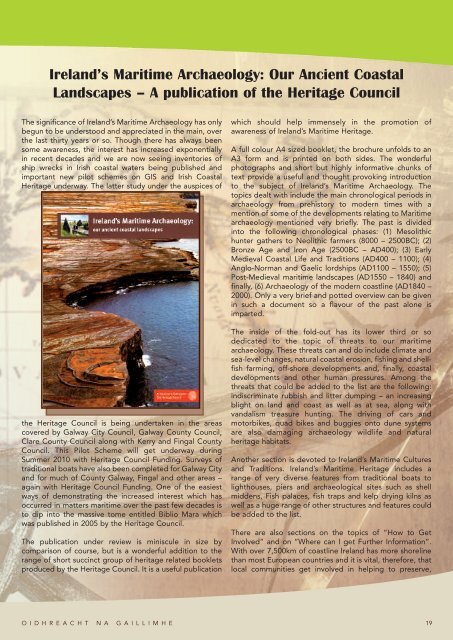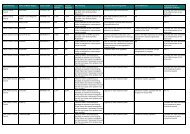GALWAY'S HERITAGE OIDHREACHT NA GAILLIMHE GALWAY'S ...
GALWAY'S HERITAGE OIDHREACHT NA GAILLIMHE GALWAY'S ...
GALWAY'S HERITAGE OIDHREACHT NA GAILLIMHE GALWAY'S ...
Create successful ePaper yourself
Turn your PDF publications into a flip-book with our unique Google optimized e-Paper software.
Ireland’s Maritime Archaeology: Our Ancient Coastal<br />
Landscapes – A publication of the Heritage Council<br />
The significance of Ireland’s Maritime Archaeology has only<br />
begun to be understood and appreciated in the main, over<br />
the last thirty years or so. Though there has always been<br />
some awareness, the interest has increased exponentially<br />
in recent decades and we are now seeing inventories of<br />
ship wrecks in Irish coastal waters being published and<br />
important new pilot schemes on GIS and Irish Coastal<br />
Heritage underway. The latter study under the auspices of<br />
the Heritage Council is being undertaken in the areas<br />
covered by Galway City Council, Galway County Council,<br />
Clare County Council along with Kerry and Fingal County<br />
Council. This Pilot Scheme will get underway during<br />
Summer 2010 with Heritage Council Funding. Surveys of<br />
traditional boats have also been completed for Galway City<br />
and for much of County Galway, Fingal and other areas –<br />
again with Heritage Council Funding. One of the easiest<br />
ways of demonstrating the increased interest which has<br />
occurred in matters maritime over the past few decades is<br />
to dip into the massive tome entitled Biblio Mara which<br />
was published in 2005 by the Heritage Council.<br />
The publication under review is miniscule in size by<br />
comparison of course, but is a wonderful addition to the<br />
range of short succinct group of heritage related booklets<br />
produced by the Heritage Council. It is a useful publication<br />
which should help immensely in the promotion of<br />
awareness of Ireland’s Maritime Heritage.<br />
A full colour A4 sized booklet, the brochure unfolds to an<br />
A3 form and is printed on both sides. The wonderful<br />
photographs and short but highly informative chunks of<br />
text provide a useful and thought provoking introduction<br />
to the subject of Ireland’s Maritime Archaeology. The<br />
topics dealt with include the main chronological periods in<br />
archaeology from prehistory to modern times with a<br />
mention of some of the developments relating to Maritime<br />
archaeology mentioned very briefly. The past is divided<br />
into the following chronological phases: (1) Mesolithic<br />
hunter gathers to Neolithic farmers (8000 – 2500BC); (2)<br />
Bronze Age and Iron Age (2500BC – AD400); (3) Early<br />
Medieval Coastal Life and Traditions (AD400 – 1100); (4)<br />
Anglo-Norman and Gaelic lordships (AD1100 – 1550); (5)<br />
Post-Medieval maritime landscapes (AD1550 – 1840) and<br />
finally, (6) Archaeology of the modern coastline (AD1840 –<br />
2000). Only a very brief and potted overview can be given<br />
in such a document so a flavour of the past alone is<br />
imparted.<br />
The inside of the fold-out has its lower third or so<br />
dedicated to the topic of threats to our maritime<br />
archaeology. These threats can and do include climate and<br />
sea-level changes, natural coastal erosion, fishing and shellfish<br />
farming, off-shore developments and, finally, coastal<br />
developments and other human pressures. Among the<br />
threats that could be added to the list are the following:<br />
indiscriminate rubbish and litter dumping – an increasing<br />
blight on land and coast as well as at sea, along with<br />
vandalism treasure hunting. The driving of cars and<br />
motorbikes, quad bikes and buggies onto dune systems<br />
are also damaging archaeology wildlife and natural<br />
heritage habitats.<br />
Another section is devoted to Ireland’s Maritime Cultures<br />
and Traditions. Ireland’s Maritime Heritage includes a<br />
range of very diverse features from traditional boats to<br />
lighthouses, piers and archaeological sites such as shell<br />
middens, Fish palaces, fish traps and kelp drying kilns as<br />
well as a huge range of other structures and features could<br />
be added to the list.<br />
There are also sections on the topics of “How to Get<br />
Involved” and on “Where can I get Further Information”.<br />
With over 7,500km of coastline Ireland has more shoreline<br />
than most European countries and it is vital, therefore, that<br />
local communities get involved in helping to preserve,<br />
O I D H R E A C H T N A G A I L L I M H E 19




![Download Tenant Handbook [English] - Galway City Council](https://img.yumpu.com/8735546/1/184x260/download-tenant-handbook-english-galway-city-council.jpg?quality=85)